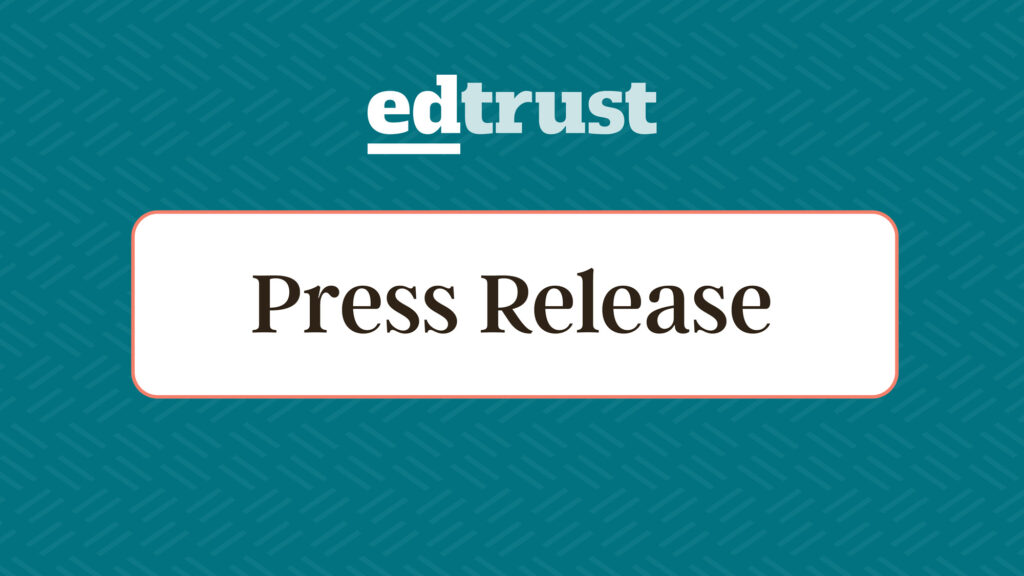New EdTrust Resource Shows How to Expand Promise of Recent State Literacy Efforts So All Children Have the Right to Read
Suite of resources offers practical tactics to improve outcomes for all students

CONTACT:
Carolyn Phenicie, cphenicie@edtrust.org
FOR IMMEDIATE RELEASE
New EdTrust Resource Shows How to Expand Promise of Recent State Literacy Efforts So All Children Have the Right to Read
Suite of resources offers practical tactics to improve outcomes for all students
WASHINGTON – Literacy is a civil right denied to too many students, and urgent action is needed to build on ongoing state advances to improve outcomes for Black and Latino students, English learners, and others historically — and currently — being blocked from becoming proficient, engaged readers.
Data paints a stark picture. The most recent National Assessment of Education Progress (NAEP) showed that only 30% of fourth grade students are proficient in reading, and just 16% of Black students, 20% of Latino students, 8% of English learners, 10% of students with disabilities, and 19% of students from low-income backgrounds can read proficiently by the fourth grade. Students are less engaged, too: just 14% of eighth graders reported reading for fun almost every day in 2023, lower than all previous NAEP assessment years.
Though more than 40 states have adopted laws to promote evidence-based reading instruction, much more needs to be done to ensure that all students have equitable access to high-quality instruction and sufficient resources to become proficient readers, which will help inspire a love of reading, and make them active participants in their own literacy development. This work is even more urgent given looming threats to federal funding for education and the loss of other programs crucial for students’ development, like Medicaid and SNAP – all part of the Great American Heist.
The consequences of poor literacy development reverberate across a student’s life, leading to lower rates of high school graduation and college enrollment, as well as limitations in the workforce and reduced participation in American democracy. Recent improvements in state policy are further at risk from threats to Head Start, cuts to research evaluating reading instructional practices, and cuts to other federally funded regional technical assistance and research supports.
Today, EdTrust released a series of publications laying out how states should build on recent reforms to ensure more equitable reading opportunities and outcomes for all students.
In general, states should work toward six principles to achieve equity in literacy efforts:
Additional resources released today offer specific actions advocates should seek in their states and districts, like supporting educators via ongoing professional development; improving teacher preparation; using assessments to identify and support students with additional needs, including those with dyslexia; and increasing funding for high-quality early learning programs for children from underserved backgrounds.
Any effort to improve literacy must be implemented using balanced, representative materials. However, these efforts are undercut by state and national efforts to ban diverse books and lessons and weaponize the identities of communities of color and the LGBTQ+ community.
“Every student has the right to read and to learn to read using rigorous, diverse instructional materials and the most effective instruction. States have made great strides in promoting a focus on evidence-based reading, but more must be done to realize the full promise of these efforts so that all students can become skillful and engaged readers,” said Shayna Levitan, a P-12 policy analyst at EdTrust and author of the report.
EdTrust’s report, which outlines guiding principles for advocates, was informed by engagement with its 2024-2025 Advisory Council. EdTrust also released recommendations for adopting or strengthening state policy in pursuit of the principles, an implementation guide for equitable access to strong reading interventions, an advocacy guide for local community action, and a compilation of pieces showcasing the need for more complex representation of various communities, with book recommendations across reading levels and represented communities.
This report follows EdTrust-New York’s release, “Every Grade Counts: The State of Adolescent Literacy in New York,” to raise awareness and urgency about the literacy crisis facing older students across New York. This report also highlights promising practices in adolescent literacy from across New York and the nation, offering a blueprint for education leaders to support these students at both the state and district levels.
###
About EdTrust
EdTrust is committed to advancing policies and practices to dismantle the racial and economic barriers embedded in the American education system. Through our research and advocacy, EdTrust improves equity in education from preschool through college, engages diverse communities dedicated to education equity and justice, and increases political and public will to build an education system where students will thrive.